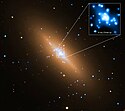Sextanten
- För instrumentet, se Sextant.
| Sextanten | |
 | |
| Lista över stjärnor i Sextanten | |
| Latinskt namn | Sextans |
|---|---|
| Förkortning | Sex |
| Rektascension | 10[1] h |
| Deklination | 0[1]° |
| Area | 314 grad² (47) |
| Huvudstjärnor | 3 |
| Bayer/Flamsteedstjärnor | 28 |
| Stjärnor med exoplaneter | 5 |
| Stjärnor med skenbar magnitud < 3 | 0 |
| Stjärnor närmare än 50 ljusår | 5 |
| Ljusaste stjärnan | Alfa Sextantis (4,49m) |
| Närmaste stjärnan | LHS 292 (14,80 lå) |
| Messierobjekt | 0 |
| Meteorregn | Sextantiderna |
| Närliggande stjärnbilder | Bägaren, Lejonet, Vattenormen |
| Synlig vid latituder mellan +80° och −-90° Bäst synlig klockan 21:00 under april. | |
Sextanten (Sextans på latin) är en liten svag stjärnbild vid himmelsekvatorn.[2][3] Sextanten är en av de 88 moderna stjärnbilderna som erkänns av den internationella astronomiska unionen.[4]
Historik
Stjärnbilden var inte en av de 48 konstellationerna som listades av den antike astronomen Ptolemaios i hans samlingsverk Almagest. Stjärnbilden introducerades först 1687 av den polske astronomen Jan Hevelius.
Stjärnor
Sextanten är en ljussvag stjärnbild som bara innehåller en stjärna ljusstarkare än magnitud 5.[4]
- α - Alfa Sextantis är en vit jättestjärna av spektraltyp A0III. Magnituden är 4,49[5]
- β - Beta Sextantis är en variabel stjärna av ungefär magnitud 5,0
- γ - Gamma Sextantis är en trippelstjärna av magnitud 5,07
- δ - Delta Sextantis, blåvit dvärgstjärna av spektraltyp B9.5V och magnitud 5,19
- ε - Epsilon Sextantis, gul-vit jätte av spektraltyp F2 III och magnitud 5,25
- LHS 292 är en röd dvärg av magnitud 15,60 som är en flarestjärna[6]
Djuprymdsobjekt


Stjärnbilden innehåller inga Messierobjekt, men flera andra intressanta objekt.[7][4]
- NGC 3115 (Spindelgalaxen, Caldwell 53) är en linsformad galax av magnitud 9,9. Den har ett svart hål i centrum som är beräknat till mer än 1 miljard solmassor.[8]
- NGC 3166 är också en spiralgalax och ligger 50000 ljusår från NGC 3169. De båda galaxerna kommer så småningom att smälta samman till en stor.[4]
- NGC 3169 är en spiralgalax som återfinns strax under Regulus i Lejonets stjärnbild. Supernovan SN 2003cg upptäcktes i galaxen 2003.
- Sextans A (UGCA 205) är en oregelbunden galax i lokala galaxhopen
- Sextans B (UGC 5373 eller DDO 70) är en oregelbunden galax, på 4,5 miljoner ljusårs avstånd. Den är den mest avlägsna medlemmen av den lokala galaxhopen.
Referenser
- ^ [a b] ”Sextans, constellation boundary”. The Constellations. International Astronomical Union. http://www.iau.org/public/constellations/#sex. Läst 24 april 2014.
- ^ Ian Ridpath och Wil Tirion (2007). Stars and Planets Guide. Princeton University Press, Princeton. ISBN 978-0-00-725120-9
- ^ ”De nutida stjärnbilderna”. Naturhistoriska Riksmuseet. http://www.nrm.se/faktaomnaturenochrymden/rymden/denutidastjarnbilderna.2277.html. Läst 24 april 2014.
- ^ [a b c d] ”Sextans Constellation”. http://www.constellation-guide.com/constellation-list/Sextans-constellation/. Läst 24 april 2014.
- ^ ”Basic data: Alpha Sex -- Star”. Centre de Données astronomiques de Strasbourg. http://simbad.u-strasbg.fr/simbad/sim-basic?Ident=Alpha+Sex&submit=SIMBAD+search. Läst 24 april 2014.
- ^ ”Basic data: GJ 3622 -- Flare Star”. Centre de Données astronomiques de Strasbourg. http://simbad.u-strasbg.fr/simbad/sim-basic?Ident=LHS+292&submit=SIMBAD+search. Läst 24 april 2014.
- ^ Astronomica – Galaxer – planeter – stjärnor – stjärnbilder – rymdforskning. Tandem Verlag GmbH (svensk utgåva). 2007. sid. 458-459. ISBN 978-3-8331-4371-7
- ^ ”Basic data: NGC 3115 -- Galaxy in Group of Galaxies”. Centre de Données astronomiques de Strasbourg. http://simbad.u-strasbg.fr/simbad/sim-basic?Ident=NGC+3115&submit=SIMBAD+search. Läst 24 april 2014.
Externa länkar
 Wikimedia Commons har media som rör Sextanten.
Wikimedia Commons har media som rör Sextanten.
| ||||||||||||||||||||||
Media som används på denna webbplats
The galaxy NGC 3115 is shown here in a composite image of data from NASA's Chandra X-ray Observatory and the European Southern Observatory's Very Large Telescope (VLT). Using the Chandra image, the flow of hot gas toward the supermassive black hole in the center of this galaxy has been imaged. This is the first time that clear evidence for such a flow has been observed in any black hole.
The Chandra data are shown in blue and the optical data from the VLT are colored gold. The point sources in the X-ray image are mostly binary stars containing gas that is being pulled from a star to a stellar-mass black hole or a neutron star. The inset features the central portion of the Chandra image, with the black hole located in the middle. No point source is seen at the position of the black hole, but instead a plateau of X-ray emission coming from both hot gas and the combined X-ray emission from unresolved binary stars is found.
To detect the black hole's effects, astronomers subtracted the X-ray signal from binary stars from that of the hot gas in the galaxy's center. Then, by studying the hot gas at different distances from the black hole, astronomers observed a critical threshold: where the motion of gas first becomes dominated by the supermassive black hole's gravity and falls inwards. The distance from the black hole where this occurs is known as the "Bondi radius."
As gas flows toward a black hole it becomes squeezed, making it hotter and brighter, a signature now confirmed by the X-ray observations. The researchers found the rise in gas temperature begins at about 700 light years from the black hole, giving the location of the Bondi radius. This suggests that the black hole in the center of NGC 3115 has a mass of about two billion times that of the Sun, supporting previous results from optical observations. This would make NGC 3115 the nearest billion-solar-mass black hole to Earth.
NGC 3115 is located about 32 million light years from Earth and is classified as a so-called lenticular galaxy because it contains a disk and a central bulge of stars, but without a detectable spiral pattern.Sextans B dwarf galaxy by Hubble space telescope
Författare/Upphovsman: IAU and Sky & Telescope magazine (Roger Sinnott & Rick Fienberg), Licens: CC BY 3.0
IAU Sextans chart




